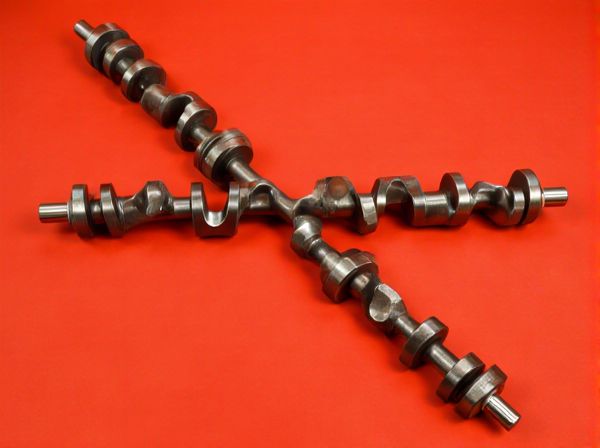
Photo illustration: Nitrided vs Non-nitrided Crankshaft
Nitrided crankshafts undergo a surface hardening process that enhances wear resistance and fatigue strength, making them more durable under high-stress conditions. Non-nitrided crankshafts lack this treatment but can still perform well with proper material selection and maintenance. Your choice depends on the engine's performance requirements and expected operational demands.
Table of Comparison
| Feature | Nitrided Crankshaft | Non-Nitrided Crankshaft |
|---|---|---|
| Surface Hardness | High (enhanced wear resistance) | Standard (lower surface hardness) |
| Fatigue Strength | Improved (resists cracking under stress) | Moderate (more prone to fatigue failure) |
| Corrosion Resistance | Increased (due to nitriding layer) | Lower (requires additional coatings) |
| Manufacturing Process | Requires controlled nitriding treatment | Traditional heat treatment or machining |
| Cost | Higher (due to nitriding process) | Lower (standard manufacturing) |
| Performance | Better durability in high-stress engines | Sufficient for standard engine applications |
Introduction to Crankshaft Material Treatments
Nitrided crankshafts undergo a surface hardening process using nitrogen diffusion, significantly enhancing wear resistance, fatigue strength, and corrosion protection compared to non-nitrided crankshafts. Non-nitrided crankshafts, often made from forged or cast steel, rely primarily on their base material properties and traditional heat treatments for durability. The choice between nitrided and non-nitrided crankshafts influences engine reliability and performance under high-stress operating conditions.
What is Nitriding in Crankshafts?
Nitriding in crankshafts is a thermochemical surface hardening process that introduces nitrogen into the steel alloy's surface layer to enhance wear resistance, fatigue strength, and corrosion resistance. The nitriding process forms a hard, thin compound layer and diffusion zone, which significantly improves the crankshaft's durability without requiring additional heat treatment. Compared to non-nitrided crankshafts, nitrided crankshafts exhibit superior surface hardness, reduced friction, and extended service life under high-stress engine conditions.
Manufacturing Process: Nitrided vs Non-nitrided
Nitrided crankshafts undergo a surface hardening process involving the diffusion of nitrogen into the steel at temperatures between 500-580degC, enhancing wear resistance and fatigue strength. Non-nitrided crankshafts are typically manufactured through forging or casting, followed by standard heat treatments like quenching and tempering, without the nitrogen diffusion step. This distinction in manufacturing results in nitrided crankshafts exhibiting superior surface hardness and improved fatigue life compared to their non-nitrided counterparts.
Surface Hardness and Wear Resistance Comparison
Nitrided crankshafts exhibit significantly higher surface hardness, typically ranging from 900 to 1100 HV, compared to non-nitrided crankshafts whose hardness usually falls around 400 to 600 HV. The nitriding process introduces a hardened diffusion layer rich in nitrogen, greatly enhancing wear resistance and fatigue strength under high-stress conditions. Non-nitrided crankshafts, lacking this hardened surface, demonstrate increased susceptibility to surface wear and reduced durability during prolonged engine operation.
Performance Differences in High-Stress Applications
Nitrided crankshafts exhibit superior fatigue resistance and enhanced surface hardness compared to non-nitrided crankshafts, resulting in improved durability and reliability under high-stress conditions. The nitriding process creates a hardened case layer that reduces wear and increases tensile strength, leading to better performance in engines subjected to extreme loads and high RPMs. Non-nitrided crankshafts, while often less expensive, lack this enhanced surface treatment, making them more susceptible to fatigue failure and wear in demanding applications.
Fatigue Life and Durability
Nitrided crankshafts exhibit significantly improved fatigue life and durability compared to non-nitrided crankshafts due to the formation of a hard, wear-resistant surface layer that reduces stress concentrations and resists surface cracks. The nitriding process enhances surface hardness up to 1100 HV, resulting in superior resistance to fatigue failure under cyclic loading conditions. Non-nitrided crankshafts lack this hardened surface, leading to increased susceptibility to wear, fatigue cracks, and reduced overall lifespan, especially in high-performance or heavy-duty engine applications.
Cost Analysis: Nitrided vs Non-nitrided Crankshafts
Nitrided crankshafts incur higher initial manufacturing costs due to the specialized surface hardening process, which enhances fatigue resistance and wear properties, reducing maintenance expenses over time. Non-nitrided crankshafts have lower upfront costs but may require more frequent repairs and replacements because of increased susceptibility to surface wear and fatigue failure. Long-term cost analysis favors nitrided crankshafts for high-performance or heavy-duty applications, where durability offsets the initial investment.
Common Automotive and Industrial Applications
Nitrided crankshafts, treated with a nitrogen-rich surface hardening process, offer enhanced fatigue strength, wear resistance, and corrosion protection, making them ideal for high-performance automotive engines and demanding industrial machinery. Non-nitrided crankshafts, typically made from forged or cast steel without surface treatments, are commonly used in standard passenger vehicles and light industrial equipment where cost efficiency and moderate durability are prioritized. The nitriding process extends the service life and reliability of crankshafts in heavy-duty applications, such as commercial trucks and heavy machinery, by improving surface hardness and resistance to stress-related failures.
Maintenance and Longevity Considerations
Nitrided crankshafts exhibit superior wear resistance and corrosion protection due to their hardened surface layer, reducing maintenance frequency and extending overall lifespan compared to non-nitrided crankshafts. Non-nitrided crankshafts require more frequent inspections and oil analysis to detect early signs of wear or fatigue because they lack the enhanced surface hardness provided by nitriding. Choosing nitrided crankshafts improves longevity and lowers long-term maintenance costs in high-performance and heavy-duty engine applications.
Choosing the Right Crankshaft for Your Engine
Selecting the right crankshaft for your engine involves weighing the benefits of nitrided versus non-nitrided options; nitrided crankshafts offer enhanced surface hardness and improved wear resistance due to the nitrogen diffusion process, which significantly extends component life under high-stress conditions. Non-nitrided crankshafts, while generally less expensive, provide sufficient strength for standard performance applications but may require additional surface treatments or frequent maintenance to prevent wear and fatigue. Consider engine application, load demands, and budget constraints to determine if the superior durability and reduced maintenance of nitrided crankshafts align with your performance goals.
 caratoz.com
caratoz.com